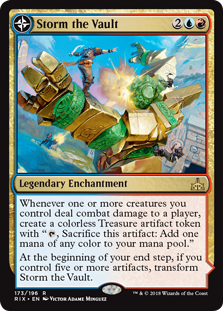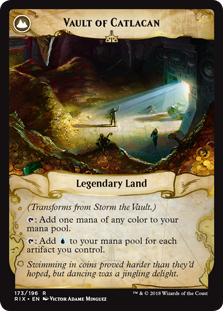There’s an old mindset among the more alpha Magic players that casual Magic play is a less sophisticated approach, requiring less skill and less focus in order to succeed. Which, when compared to the stringent and often constricting deck building nature of nearly all tournament formats, that very well may be true. Objectively speaking, it is harder to concoct a viable, winnable deck when you only have a few sets or even mere packs at your disposal. There undoubtedly are more factors that have to be weighed in deck construction to ensure that you can make the best out of the limitations being presented to you. Few would argue to the contrary. But to insist that your ability to turn card drafts into an okay Limited deck against other okay Limited decks puts your Magic skills at a higher level than casual players solely based on those circumstances is both arrogant and folly. Yes, casual gameplay doesn’t insist on having the smallest deck possible and yes, it can pull from the vast catalog of cards amassing before us over 25 years, but that hardly designates it as an also-ran of Magic gameplay. (Lest we forget, the vast majority of Magic games are casual in nature.) The mindest that it’s at a lower tier of technical aptitude or deserved recognition is as old as the game itself, largely enacted by Constructed players as a way of elevating themselves as doing something more profound and reinforced by Wizards as a means of propagating their most ardent revenue-generating avenues.
It’s a salty issue among many casuals, including myself, because there are plenty of us who are just as experienced and cunning as our Magic cohorts but dislike the tournament atmosphere for a variety of reasons. It doesn’t automatically mean casual Magic, particular of the multiplayer variety, is conducted at a lower level. I’ve lost track of the number of tournament folk who filtered through our Magic cadre over the years whose decks and tactics were admirable to a fault in a duel but quickly fell apart when staring down four opponents instead of one. Not because of luck. Not because of a poor deck. But because of the age old tale of hubris: they walked in assuming they were destined to win but were made to realize casual doesn’t inherently mean amateur.
For further reference, go grab any sports movie; you have about a 1/3 chance of watching one with a plot around this exact premise.
That all being said, casual Magic gameplay is not homogeneous. Many game groups will behave wildly different than one another. Some may prefer (or profoundly dislike) one style of gameplay over another. More aggressive? More defensive? Some groups like to turret until they can win by overwhelming force. Others may prefer to chip away at one another piece by piece. Some groups thrive on multiplayer table politics and the ever-changing table state it produces, whereas many try to minimize this behavior. And then there are the card pools themselves.
Again, while hardly ubiquitous among every casual group, it’s not unheard of to have their own subset of house rules and / or their own ban list of sorts – be it a ‘soft ban’ of trying to get someone to not play a specific deck or a ‘hard ban’ of, say, outlawing cards with Annihilator or Infect, each group has the ability to set their own terms in order to foster the desired atmosphere they wish. Most don’t go down this road much, but the opportunity is always there should your particular meta wishes to.
When it comes to my own gaming circles over the years, we adhered to a minimalist approach. Rather than house ban specific cards, decks, or mechanics (and we certainly have had many in ardent favor of such from time to time), we always settled instead of policing the players’ actions themselves. If one particular player ended up playing in a certain way or used certain cards that were making the game fun prohibitive, they were usually targeted early on as a self-correcting measure. It’s a bit more of a passive approach, but it generally worked better than simply stating what someone can or can’t do by decree.
The only real exception to that were cards we felt were out of bounds as ‘normal’ cards. In the very early days, this was solely ante cards – an early Magic concept where players actually wagered away cards from their deck on the outcome of the game. Eventually this grew to include the first two Portal sets as they were deemed tutorial cards and the joke cards from the Unglued series. Other than that, pretty much everything else was considered fair game.
Curiously though, we’d noticed over time that a number of our players had a tendency of actively avoiding another set of cards as we moved more and more solidly into the realm of EDH. These were transform cards. At first this was of little concern as few of the original Innistrad transform cards really jumped out as decent Commander options. (There are a handful.) Yet it became more noticeable as the mechanic returned in Magic Origins, Shadows over Innistrad, and Ixalan, despite that card pool became more and more enticing.
The reasoning was incredibly pragmatic. Many players decided not to bother using them not because of their power level or perceived legality but because of the extra energy needed to make transform cards easily work in a sleeved Commander deck. Either you need to sleeve the card on one side and flip it in-game at the appropriate time (needing to remember what the cards do or risk tipping your hand), or you need to use a checklist card and carry around the requisite transform cards separately from the deck. Either of which can be annoying. So much so that many in our groups simply decided to slot a different card instead. Most felt they weren’t worth the trouble, especially if it was the only card in the deck.
I, however, was not one of those people. Because there are quite a few interesting transform cards that simply shine in Commander if given the opportunity, and they deserve to be used as such. And it is with that in mind that we come to this week’s card.
Today we have: Storm the Vault / Vault of Catlacan


Name: Storm the Vault / Vault of Catlacan
Edition: Rivals of Ixalan
Rarity: Rare
Focus: Discard / Board Control
Highlights: Among the spectrum of available transform cards, Storm the Vault lies in the middle, being neither the weakest nor the most bananas. Yet what this Enchantment into Land card offers is well worth the consideration, both because of its potential advantages in the right circumstances, and more importantly, because unlike some of its brethren, you don’t actually have flip it for it to be a useful card. Yes, at its most benign, Storm the Vault is a mana and artifact generating Enchantment for two colors that can easily make use of both.
The front side of Storm the Vault starts off as a Red / Blue Enchantment for four mana, putting it right on par with cards of similar power level. This provides you with a useful combat trigger in a similar mindset to a thematically adjacent card like Coastal Piracy, stating that whenever a creature you control deals combat damage to an opponent, you get a Treasure artifact. These artifacts serve two purposes, depending on your ambitions. With an artifact-centric deck it provides a cheap and plentiful means of building up (particularly) expendable artifacts to perform a variety of tasks. More generally, these tokens serve as an available, albeit temporary, mana boost. This can be particularly handy when needing to cast several spells in succession or paying for an expensive spell more quickly – something both of these colors do in abundance. Even if mana acceleration wasn’t the primary goal, Storm the Vault at the very least offers up a smoothing mechanic for two colors that can fall behind the mana game. Having tokens at the ready to sacrifice for mana as needed can be incredibly advantageous to stay competitive in the early and middle stages of a Commander game and can be generated with even the most minimal of combat damage.
Transforming Storm the Vault is quite simple as triggers go – all you need to do is start your turn with five unused Treasure tokens. Although this flip isn’t optional, continually using Treasure tokens to prevent this from happening is possible; if used regularly you’ll find yourself never needing to make a flip. On the other hand, if you find yourself in an abundance of Treasure, the flipped side is even more beneficial. For one, it becomes a Land that can tap for any mana, meaning that no matter what, you’re always netting one mana from the card each round. If you can keep those Treasures (or other artifacts) protected, however, you can take advantage of its second land ability made famous by its predecessor Tolarian Academy: tapping to add one Blue mana for each artifact you control. This can boost the card’s mana potential even higher in the doldrum parts of the game where you can likely benefit most from the extra mana. The history of the Academy alone speaks for the potential there.
The one tradeoff to the transformed side is that while you lose the ability to generate Treasure tokens directly, it does become a Land, making the card itself that much harder to remove.
In any case, should you choose to consider transform cards in your next Commander deck, Storm the Vaults is a prime example that this mechanic is now more than just werewolves, and if you’re willing to consider them, they can make a decent deck even better.
At least, that’s the casual perspective.
Keep an eye out for us to be regularly featuring other more accessible-but-worth-it Commander cards going forward. In the meantime, we’ll keep the light on for you.
![]()
You can discuss this article over on our social media!
